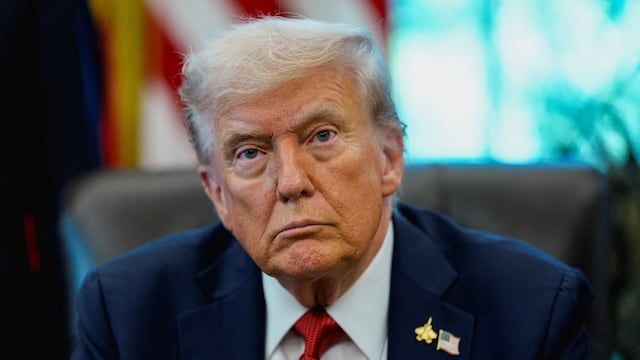The Republicans and Democrats couldn’t agree on the terms of a spending bill and were unable to avoid a federal government shutdown.

Why did the U.S. government shut down if the Republicans have a majority in the House and Senate?

The U.S. government is in the midst of a shutdown, its first in nearly seven years, with Republicans in Congress unable to secure the Democratic support they need to push through a stopgap spending bill.
What was the shutdown deadline?
Lawmakers in Washington, D.C., couldn’t agree on legislation before midnight ET, Tuesday September 30, and were unable to avoid a shutdown.
It is the first since President Trump’s first term in the White House, when deadlock in Congress led to a 35-day shutdown between December 2018 and January 2019. It was the longest in U.S. history.
Earlier in September, Republicans in the House of Representatives, Congress’s lower chamber, passed a bill that would fund the federal government until November 21. In the Senate, however, the GOP has been unable to get the votes it needs for the legislation to advance in the upper chamber.
🚨BREAKING: Unearthed video EXPOSES Trump's feelings about who is to blame for gov't shutdowns. "I actually think the President would be blamed if there is a shutdown. I think it would be a tremendously negative mark."
— Really American 🇺🇸 (@ReallyAmerican1) September 30, 2025
Share widely.#DonaldTrumpsShutdownpic.twitter.com/NcwuZmWqFY
But don’t the Republicans have control of both houses?
Yes: In the last congressional elections, held on the same day as November 2024’s presidential election, the Republican Party won a majority of seats in both the House and the Senate.
Currently, the GOP holds 219 of the 435 seats in the House - just above the threshold of 218 needed for a majority. In the Senate, meanwhile, the Republicans also have a small majority, as they account for 53 of the 100 seats.
However, while the GOP’s slim majority in the House allowed them to push their seven-week spending bill through the lower chamber, the rules of the Senate make it harder to pass a bill in the upper house.
In the House, a simple majority is good enough to approve legislation. But in the Senate, most bills - including the spending bill currently on the table - need to secure the support of at least 60 senators.
That’s because three-fifths of the Senate must agree to end the debate phase that takes place before legislation is put to a vote by the chamber. Without meeting this 60-vote threshold, the bill’s progress stalls.
Once the Senate advances to a vote on the legislation itself, this final ballot only needs a simple majority.
The 60-vote threshold appears to have been designed in an attempt to get political parties to work with each other. It “ensures that in order to pass legislation, the majority party needs to get some buy-in from the minority”, CBS News notes.
However, the desired cooperation between Republicans and Democrats is not currently in evidence. In fact, analysts say that the shutdown benefits the Republican Party.
I was a skeptic about the import of the Epstein files.
— Jason Kander (@JasonKander) October 6, 2025
But 3 invasions of cities, one military buildup outside Venezuela, a government shutdown, and so many other things meant to distract have me convinced whatever’s in there is the biggest presidential scandal in U.S. history.
GOP unable to get Dem support
Given that Republicans hold 53 seats in the Senate, they need at least seven Democrats to support their stopgap spending bill.
In return for their backing, the Dems are seeking an extension of Obamacare health-care subsidies that are due to expire at the end of 2025, and a rollback of Republican cuts to Medicaid, a program that also helps to cover Americans’ medical costs. The Dems’ demands have met with GOP opposition.
BREAKING: In a shocking moment, CNN's Harry Enten reveals that Americans overwhelmingly blame Republicans for the shutdown by as many as 17 points in 3 different opinion polls.
— Really American 🇺🇸 (@ReallyAmerican1) October 3, 2025
Americans are waking up!
Spread the word. pic.twitter.com/lojHOStp5D
Speaking on September 29, the Republican vice-president J.D. Vance said: “I think we’re headed to a shutdown because the Democrats won’t do the right thing. I hope they change their mind, but we’re going to see.”
Chuck Schumer, the Democratic Senate minority leader, countered: “[The Republicans’] bill has not one iota of Democratic input. That is never how we’ve done this before. It’s up to the Republicans whether they want a shutdown or not.”
Sen. Bernie Sanders: "[If] you reopen the government and we lose our leverage, and they say, well, ‘You know, We want this. We want that.’ No, there has to be an agreement right now. That's what this whole shutdown is about — to protect the American people and our health care… pic.twitter.com/3qlRHpcJu6
— Kaitlan Collins (@kaitlancollins) October 7, 2025
What happens to federal workers if there’s a shutdown?
According to the Congressional Budget Office, a shutdown forces federal agencies to “cease normal spending”.
Some federal employees who are considered essential - such as staff in national defense, air-traffic control and law enforcement - must continue working during a shutdown, with no guarantees that they will ever get paid.
The CBO says such workers “almost certainly” will be remunerated, but adds that this “requires specific Congressional approval”.
Federal employees not deemed essential will be furloughed: they are “placed in a non-pay, nonduty status, until the shut-down ends”, the CBO says.
Related stories
Get your game on! Whether you’re into NFL touchdowns, NBA buzzer-beaters, world-class soccer goals, or MLB home runs, our app has it all.
Dive into live coverage, expert insights, breaking news, exclusive videos, and more – plus, stay updated on the latest in current affairs and entertainment. Download now for all-access coverage, right at your fingertips – anytime, anywhere.


Complete your personal details to comment